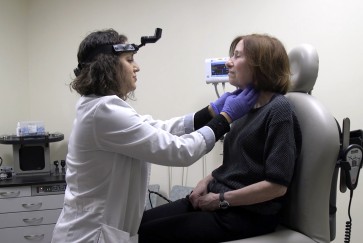Cancer epidemiologist Lifang Hou’s father was a lifelong smoker, and she urged him to quit all through her medical training. He insisted that because his parents smoked for decades and died of natural causes, he was not at risk of cancer. But sure enough, Hou’s father was diagnosed with lung cancer in 1995 and died two years later.
“I kept telling him genetic makeup does not determine all your disease outcomes — it’s also your environment and lifestyle,” Hou says. “So now I’m focused on identifying biological evidence that genetics and environment work together.”
This is Hou’s research mission: to identify biological evidence of the interplay of genes and environment in cancer. What we eat, how much we exercise, where we live and how we handle stress — Hou says these are just some of the variables that interact with our genes in cancer development. And she intends to prove it.
Not precise enough
Precision medicine considers each individual’s genetic and environmental factors to determine treatment strategies. Also known as personalized medicine, this field rejects the idea that one drug or treatment works for all patients.
Hou says that approach doesn’t go far enough.
“We’ve been applying all these precision medicine technologies to cancer treatment — making decisions about drugs and therapies based on a patient’s unique profile,” Hou says. “Now, we’re trying to do the same for cancer prevention. Without precision prevention, we’re just chasing after cancer, and we need to get ahead of it.”
From patients to populations
About five years into her work as a physician, Hou realized that if she wanted to lead pathbreaking prevention efforts, she would have to think beyond the clinic.
“As a physician, I only dealt with individual patients, but I wanted to understand what really was happening at a population level,” Hou says. “I wanted to understand the causes of cancer development and help develop tools for early detection and prevention.”
Now, Hou is specifically focused on cancer biomarkers — biological indicators of the disease — in blood. Blood-based biomarkers, she says, will allow for simpler, lower-cost tests that can be deployed in physicians’ offices during routine check-ups. Equally important: These biomarkers are indisputable.
“We can’t just say to policymakers, ‘pesticides maybe can cause cancer,’” Hou says. “We have to bring the science along and show them the truth. And then we share our findings with the public.”
Chromosome caps
Changes in telomere length may be one such biomarker. Telomeres are the protective end caps at each of our chromosomes. Our telomeres typically get shorter as we age, but environmental factors — diet, smoking, exposure to pesticides, air pollution and heavy metals — can also contribute to premature shortening. And, Hou has found, changes in telomere length over time may be an indicator of oncoming cancer.

In a retrospective study, Hou and her team looked at telomere length over a 13-year period in almost 800 people, 135 of whom eventually received a cancer diagnosis. Telomeres for everyone shortened each year for several years, but among those who were eventually diagnosed with cancer, telomeres shortened much faster — appearing 15 years older, in some cases — than those who were not subsequently diagnosed with cancer.
And even more surprisingly, the telomeres of people who eventually received a cancer diagnosis stopped shortening about 3-4 years before their diagnosis, while the telomeres of people who were not diagnosed with cancer continued to shorten.
This research is the first reported trajectory of telomere changes over many years in people who eventually develop cancer. It is also believed to be the first to look at telomere length at more than one point before diagnosis. Hou says this is significant, because cancer treatment itself can change telomere length, making it difficult to know to what extent telomere length has been impacted by cancer itself.
Telomeres typically shorten with age:
 Telomeres that shorten more quickly than normal might indicate greater risk of future cancer:
Telomeres that shorten more quickly than normal might indicate greater risk of future cancer:
 Telomeres that stopped or slowed their shortening may also be a sign of oncoming cancer:
Telomeres that stopped or slowed their shortening may also be a sign of oncoming cancer:
 The timing of these telomere changes, relative to each other, may help predict cancer.
The timing of these telomere changes, relative to each other, may help predict cancer.
Hou’s team is now expanding this telomere work on a grand scale. Collaborating with well-known scientists across the globe, Hou’s team is studying large population cohorts and using deep sequencing data to examine telomere changes with an unprecedented level of detail.
“Current technology calculates an average telomere length across all 26 chromosomes,” says Hou’s collaborator Brian Joyce. “This will allow us to look at telomeres on each chromosome separately, which is much more detailed and potentially biologically relevant.”
Full-court prevention
Hou envisions a day when routine, annual lab testing measures a patient’s telomere length alongside conventional metrics like blood cell count and cholesterol level. If their telomere length has changed significantly from one year to the next, the doctor would follow up to see what’s changed in the patient’s life — their diet, exercise routine, stress level, etc.
Hou hopes physicians will also be able to use blood-based telomere length for “risk stratificiation,” identifying those who would benefit from more invasive, costly screenings like colonoscopies.
Hou is committed to studying multiple biomarkers, including telomere length, because she understands the complexity of cancer. Telomeres can’t tell the whole story — genes and environment are far too vast and variable — but they could be a valuable preventive tool.
“One type of biomarker might not be sufficient,” Hou says. “We hope that by studying several biomarkers, we can eventually combine these indicators into a simple blood test.”
By quickly and inexpensively identifying people at an increased risk of cancer, this test could greatly advance efforts to combat the disease earlier — and perhaps even prevent cancer in the first place.

